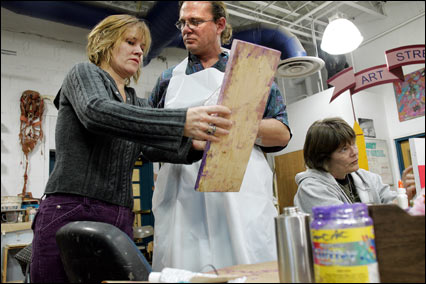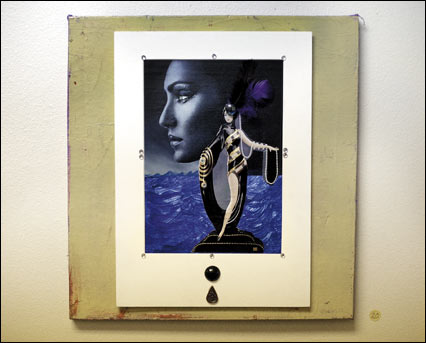
Their diagnoses of bipolar disorder brought them together, but working on their art - here at the community cooperative studio Art Street - is what has truly bonded (from left) Julianna Stafford Pelletier, Tony Pelletier and Gail Donnelly. (Rick Scibelli, Jr./Special for the Tribune) The three friends - who had met because "we all get our meds in the same place," says Donnelly - started tossing around ideas for a title for the proposed exhibit. "I said, `Hey, I know - we'll call it BiPol Art,' " recalls Donnelly. "And then we all laughed." Though Donnelly admits the moniker was "kind of a wink and a nudge, you know?" it stuck. "BiPol Art," a mixed-media showing of almost 40 works by the three - each of whom has a form of bipolar disorder or manic depression - will hang at the Mental Health Housing Coalition through Jan. 30. It is a wide-ranging exhibit - acrylics hang side by side with shadow boxes and collages made from materials as diverse as drawer pulls and Chinese fans. Titles like "The End of Living" brush up against "Giggles," "Smitten" and "Garbage Garden." Each of the three artists has a unique story to tell about how they came to produce their work, but one sentiment bonds them all: "Art has saved our lives," Stafford Pelletier says. Donnelly, 45, who got in trouble as a child for drawing on walls, came to Albuquerque in the summer of 2004. Homeless for six months, she was directed to the community art studio Art Street through Albuquerque's Health Care for the Homeless. There she rediscovered her childhood love of art, as well as a release from the severe depressions that had led her to several suicide attempts.

"Chic," by Julianna Stafford Pelletier is one of 37 works included in "BiPol Art," a mixed-media exhibit at the Mental Health Housing Coalition. (Rick Scibelli, Jr./Special for the Tribune) "Some weeks when nothing was going right, all you were thinking was `Thank God on Thursday I can go to Art Street,' " Donnelly remembers. Stafford Pelletier and Pelletier (who, though not married, have chosen to share Tony's last name) met two years ago in Los Angeles, where Stafford Pelletier, who had suffered a breakdown, was once a top saleswoman for Ethan Allen furniture stores. They arrived in Albuquerque in April and lived in their truck until October. Pelletier, who is 43, had never done art before. Stafford Pelletier, 41, like Donnelly, loved to draw as a child. (In fact, a character from those early drawings called Josie often appears in her work today.) But both of them loved Art Street, where open studio hours two days a week and free art materials fostered their creativity. "We fell in love with the place," Pelletier says. "The only thing we didn't like about it was that it wasn't open six days a week." That was remedied when the artists discovered OffCenter, another community arts organization with open studio hours three days a week. Now, at least four days a week, you can find the three artists at one studio or the other - or at one of their homes, sometimes working on projects until 2 or 3 a.m. ("That's the manic part," Pelletier adds, laughing.) Though the Pelletiers and Donnelly had experienced mental imbalances and erratic mood swings previously, none were officially diagnosed as bipolar until they sought health care in Albuquerque last year. Bipolar disorder - or manic depression - is a disorder where abnormalities in brain chemistry cause extreme shifts in mood, energy and functioning. The artists' similar diagnoses brought them together; their art has cemented the relationship. "Art became the main connection between us," Donnelly says. "We get a lot of therapy from it. It touches somewhere on a soul level - that part of you that words can't express." When Pelletier - "who likes to crack the whip," Donnelly jokes - suggested they create a show, the women enthusiastically agreed. Their reasons for deciding to call attention to bipolar disorder through the exhibit's title, however, vary. "For me, it is bringing awareness that just because someone is bipolar, it doesn't mean they're dysfunctional," Pelletier says. "I think what this is all about is showing the benefits of art and how it has helped us," Donnelly says. "Just doing it helps get out your emotions instead of keeping them inside," Stafford Pelletier says. "I feel like I'd like people to know me because of what comes out in my art." The three have found many people hold strong misconceptions about individuals who are bipolar, often assuming they are mentally deficient. "People will look at my art real surprised and say, `You did this?' " Donnelly says. "And I'll be like, `Yeah. And I wash my hands after the restroom too.' " Just as they hope the exhibit establishes a new respect for those with bipolar disorder, they also hope it will help establish their own careers as serious artists. All but one of the 37 pieces in the show are for sale, with prices ranging from $35 to $100. The amiable trio has been talking about holding monthly shows beginning next spring. As yet, they are undecided about whether they will continue to identify their work as "BiPol Art," but at least for Pelletier, there is nothing pejorative in the label. "I'm glad of who I am," he says. "I feel like I have a foot in both worlds. And the world of the mentally ill is often a lot more caring and understanding than the other world."
